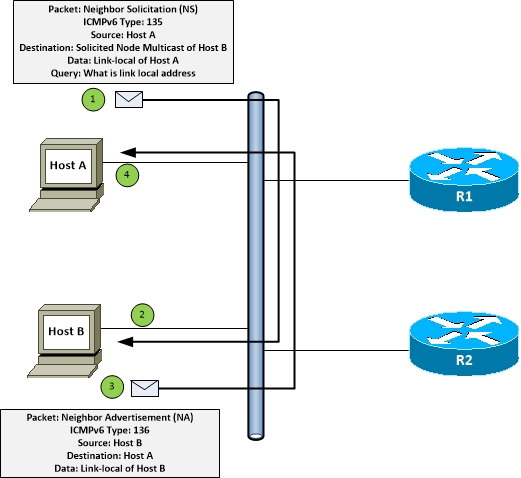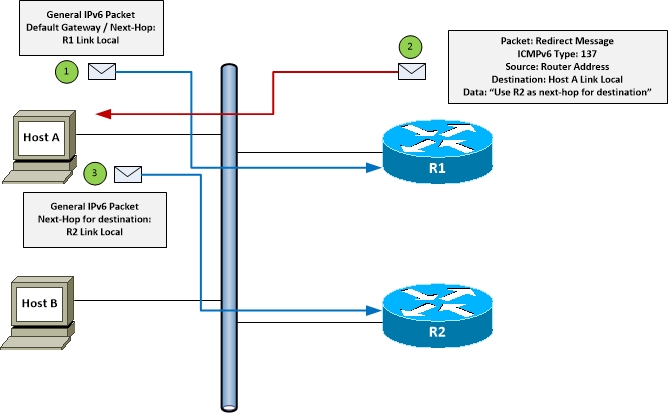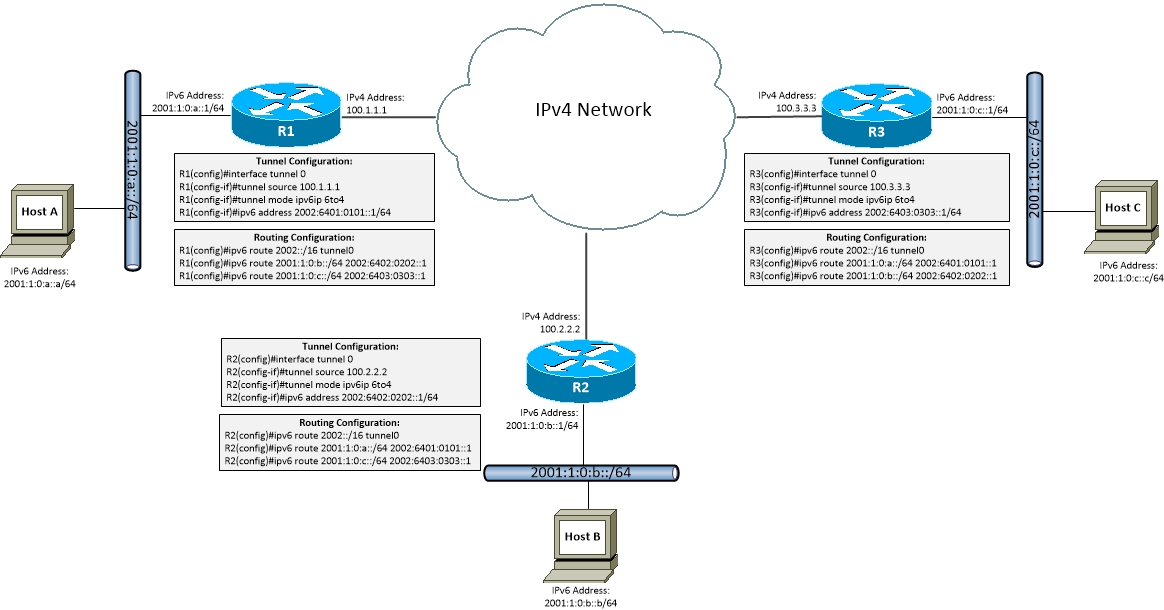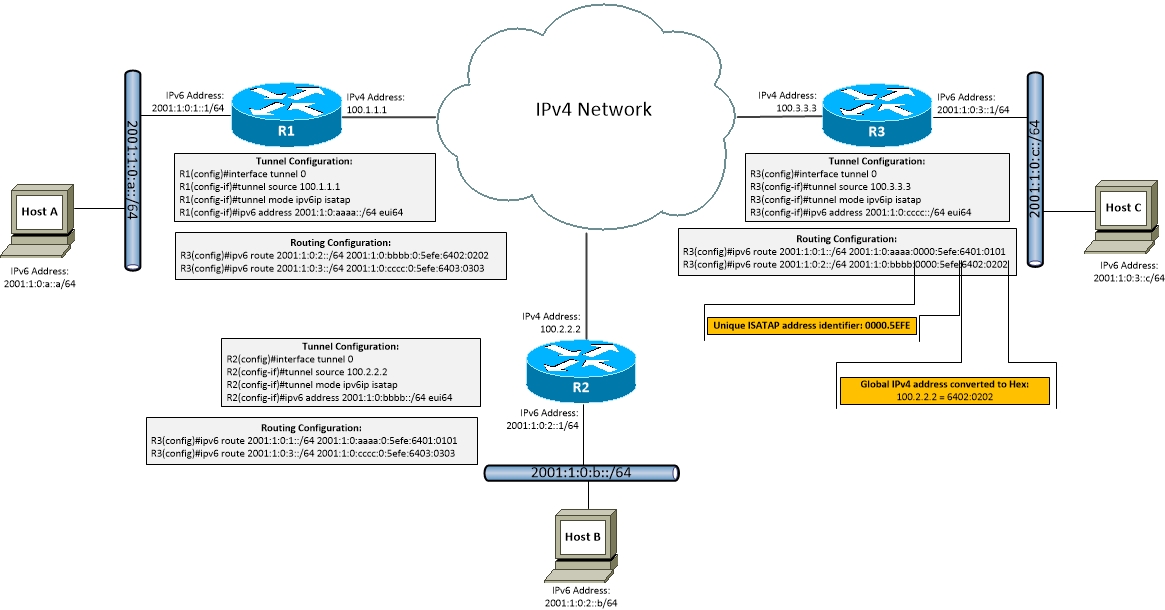IPv6 Addressing
- Much larger address space than IPv4
- IPv4 = 32 bit (4 bytes) = 2^32 = 4 billion
- IPv6 = 128 bits (16 bytes) = 2^128 = 340 undecillion
Addressing Layout
| Global Routing Prefix |
Subnet ID |
Interface ID |
| Provider |
Site |
Interface |
| <———48 bits———> |
<–16 bits–> |
<———————–64 bits————————> |
| <————————————————–128 bits————————————————–> |
- 128 bit hex addressing
- Uses CIDR notation for prefix length
- Typically uses 64 bit network portion, 64 bit host
- Global Routing Prefix
- Allows routing to the site on the Internet
- Subnet ID
- Allows admins to create subnets within a site
- Interface ID
- Globally enable unicast routing
- Disabled by default
- Command:
- (config)#ipv6 unicast-routing
- To enable on the interface
- Command:
- Enable only if using link-local addressing
- Don’t need to run if configuring a global IPv6 address on the interface
- If configuring a global address, IPv6 will automatically assign a link-local address
- Link-local address required for IPv6 to work
- IPv6 can not use secondary addressing
- All IPv6 addresses are considered primary addresses
Interface Addressing: IPv6 General Prefix
Interface Addressing: IPv6 General Prefix
- Used as a shortcut
- If company assigned a /48, all prefixes should be derrived from the /48 space
- Defined globally
- Command:
- (config)#ipv6 general-prefix <name of prefix> <prefix>
- Applied to link:
- Command
- (config-if)#ipv6 address <name of prefix> ::1/64
[_/su_spoiler]
Interface Addressing: EUI-64 Addressing
Interface Addressing: EUI-64 Addressing
- Extended Unique Identifier
- Automatically assigns IPv6 interface address based on interface MAC address
- Assigns the last 64 bits of IPv6 interface address
- Adds FF:EE in middle of address
- Invert U/L bit (universal locator) form whatever it currently is
- EUI-64 addressing Example:
- Interface MAC address = aaaa.bbbb.cccc
- Add FF:EE in the middle of the address = aaaa:bbff:eebb:cccc
- Address displayed in binary = 1001 1001 1001 1001 : 1010 1010 1111 1111 : 1110 1110 1010 1010 : 1011 1011 1011 1011
- Invert the 7th most significant bit (U/L bit) = 1001 1011 1001 1001 :
- Last 64 bits of new address = acaa:bbff:eebb:cccc
- If you enable EUI-64 on a serial link (as there is no MAC address), it takes the MAC off a different interface
- On Frame Relay networks, link-local and global unicast addresses must be mapped to DLCI's
- Can be done statically or dynamically using inverse IPv6 neighbour discovery protocol (similar to inverse ARP)
[_/su_spoiler]
Interface Addressing: Assignment Methods
Interface Addressing: Assignment Methods
Assignment Methods - STATIC
Assignment Methods - Static
- Same as IPv4 address assignment method
- Command:
- (config-if)#ipv6 address <IPv6 address/prefix>
[__/su_spoiler]
Assignment Methods - SLAAC
Assignment Methods - Stateless Address Autoconfiguration (SLAAC)
- See Router NDP: Address Autoconfiguration section
- Command:
- (config-if)#ipv6 address autoconfig
[__/su_spoiler]
Assignment Methods - STATEFUL DHCPv6
Assignment Methods - Stateful DHCPv6
- See Router NDP: Address Autoconfiguration section
- Combined with SLAAC to obtain address and DHCPv6 options from a DHCPv6 server
- Command:
- (config-if)#ipv6 address autoconfig
- (config-if)#ipv6 nd managed-config-flag
[__/su_spoiler]
Assignment Methods - STATELESS DHCPv6
Assignment Methods - Stateless DHCPv6
- See Router NDP: Address Autoconfiguration section
- Combines with SLAAC to obtain address and use DHCPv6 server to option DHCPv6 options only
- Command:
- (config-if)#ipv6 address autoconfig
- (config-if)#ipv6 nd other-config-flag
[__/su_spoiler]
[_/su_spoiler]
Interface Addressing: Types
Interface Addressing: Types
Unicast Address Types: Global Unicast
Global Unicast
- Public addresses
- Unique IPv6 address on the Internet
- Prefix:
- 2000::/3
- Binary value 011
[__/su_spoiler]
Unicast Address Types: Link-Local Unicast
Link-Local Unicast
- Address on a single link
- Not routable outside of local interface segment
- Automatically generated by default when Global address configured
- Prefix:
- FE80::/10
- Binary value 1111 1110 10
- The other 54 bits all '0'
- Prefix + Interface ID = link local address
- Used for
- Neighbor Solicitation (NS)
- Router Solicitation (RS)
- SLACC - Stateless Address Auto Configuration
[__/su_spoiler]
Unicast Address Types: Unique Local Address
Unique Local Address
- ULA - DEPRECIATED
- RFC4193
- Equivalent to RFC1918 IPv4 private addressing
- Can be assigned along with a Global Unicast and Link local address at the same time
- Don't need to specify outgoing interface
- Address made up of the following:
- FC00::/7
- Unique ID
- Link ID
- Interface ID
[__/su_spoiler]
Unicast Address Types: Global Unicast
Site-local Unicast
- Local address for a site
- Deprecated address type - RFC 3879
- Replaced by ULC (Unique Local Addresses)
- Prefix:
- FEC0::/10
- Binary value 1111 1110 11
[__/su_spoiler]
Multicast Reserved Addresses
Multicast Reserved Addresses
- FF00::/8
- 8 bits
- Binary value 1111 1111
- FF02::1
- FF02::2
- FF02::9
- All RIP Routers
- Link Local
- FF02::16
- All MLDv2 Routers
- Multicast Listener Discover
- FF05::101
- All NTP Server
- Site Local
- FF02::1:FFXX:XXXX/104
- Solicited Node Multicast address
- Low-order 24 bits replaced by low-order 24 bits of interface address
- Link Local
- All hosts on local segment required to join group
- Example:
- Link-local address of FE80::AA:1111
- Solicited node multicast address becomes FF02:0:0:0:0:1:FFAA:1111
[__/su_spoiler]
[_/su_spoiler]









